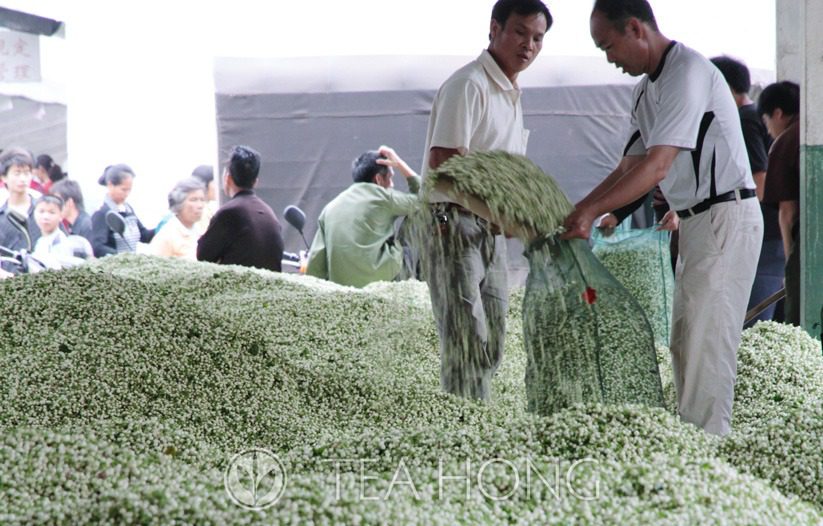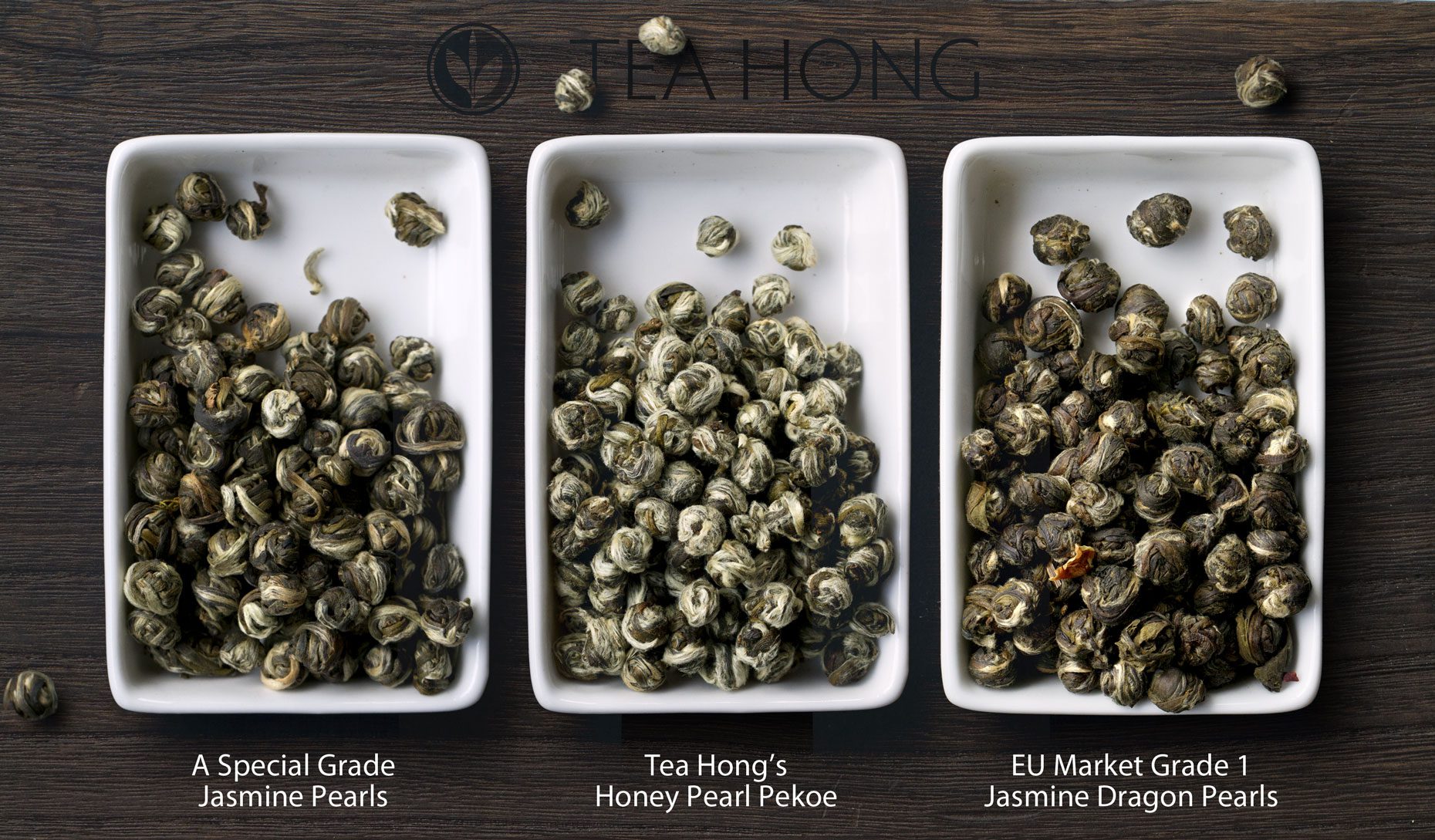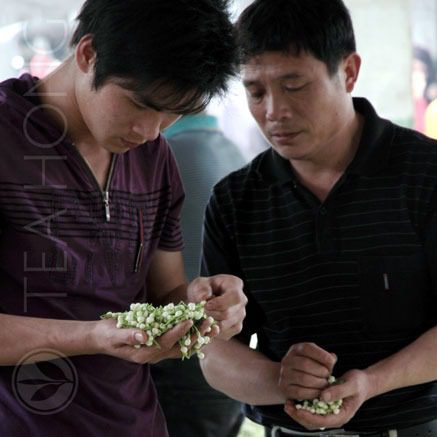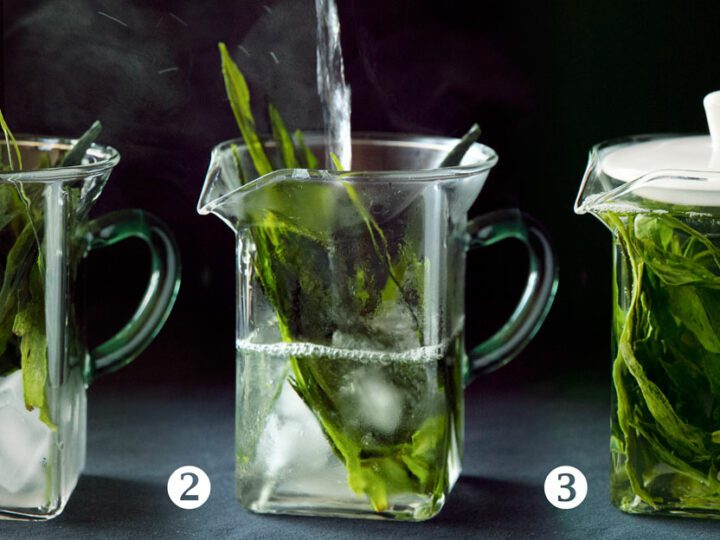There are plenty of selections for jasmine scented green tea in the market, but if you are in for a floral aroma that is pure, sweet, natural, and long lasting; a taste that is soft, silky and yet deliciously deep, something like Tea Hong’s Honey Pearl Pekoe maybe the rare find for you.
Visual clues
To the unfamiliar eye, any of those “Dragon Pearl” products may look similar. Putting them side-by-side shows clues that suggest quality difference. The much lighter colour reveals not only the use of younger and more tender leaf shoots, but also close attention and disciplines in the scenting process. Let’s see why.


If the product photo on the top of this post shows only bead size and colour, the infused tealeaves in the photo here reveals the difference of the harvest materials used in the three different tea qualities. Tea Hong’s Honey Pearl Pekoe is by far the most tender of all. Notice that not only are the other two rougher picks, they are also later picks from the tea plant — they are duller in colour, if they have been processed in the same timely manner.
Only first flush pekoe tips
For a start, we employ only first flush pekoe tips, the raw material for a smoother body and richer taste. The young leaf shoots are processed in the traditional Eastern Fujian green tea style and manually twisted into small beads. This green tea is in itself so good that some of our European clients sell it without scenting as one of their staple rare green tea selections, alongside with very fine Longjing and Huangshan Maofeng.
Pekoe tips of the Dabai cultivar is the same silvery white downy shoots that are used for Silver Needles, that is why the lighter colour to begin with.
Unlike other mass market products that are also scented with real jasmine flowers, we use a lot more flowers than tea, and a total of 7 rounds of scenting, to allow each kernel of these small beads to fully absorb the aromatic oils that are released in the brief moments when the small white flowers begin to open their tiny, delicate petals.
7 rounds of scenting


A batch of jasmine flowers being shovelled into bags made of net for delivery to a scenting factory. The net helps to keep the temperature low for the flower buds lest they could bloom before actual scenting begins.
In the scenting process, fresh jasmine buds are layered with the formed and dried little pekoe beads. The first time I stuck my hand into the one meter pile of leaves and flowers mixture I was shocked and afraid I was burnt. Huge amount of bio heat is released when these plant parts are piled together. These jasmine flowers are alive and one can actually see them opening up the petals. These lovely white flowers breath and continue their metabolic processes as if they were still in the jasmine bushes. Besides heat, there is also the moisture as a result. Both are not good for the tealeaves. They speed up oxidation of the green tea and attract microbes in the atmosphere.
To avoid quality loss the scenting master must quite immediately dry the pile and separate the flowers from the tea. Otherwise, the little beads just turn dark, as you can see in the lower grade products. One key skill to master in scenting with flowers this way is to optimise the duration to allow for maximum absorption of the bouquet essence. At the end of each round, after the flowers are separated from the pearls, the wetted tealeaves have to be taken through drying to be ready for a subsequent round of scenting.
Repeating this step intensifies the pure jasmine aroma for the tea on one hand, and ensures thorough penetration of aromatic matters into the core of the beads on another. Doing it seven times is extremely rare in the trade, because not only does each round costs labour and materials, but also the risk of ruining a complete lot in any one of the intricate steps.
Although the resultant little tea beads will always be darker in colour than the tea before scenting, the mastery in controlling the timing, piled height and use of flowers still gives us a pearl that is much lighter in colour and supremacy in aroma than the competitions.
Pure jasmine flowers


Scenting with real flowers is a lot more complex than it sounds. One element to manage is the heat and moisture given out by the flowers when piled with the tealeaves. Excessive exposure to these spoils the leaves. The duration of the piling has to be optimised so that enough fragrant matters are absorbed into the leaves while maintaining tea quality. That is why a well scented selection has to be scented a few rounds. Here a tea master from a French company poked her hand into the pile and was shocked at the heat intensity in the pile.
There is also one secret in the jasmine scenting trade: Michelia alba, a south China native tree magnolia. These long-petal, fiercely perfumed flowers are blended into jasmine to deliver instant glorification for the scenters. Many can simply do a single round and the inexperienced buyer would think that it is worth three.
However, there really is no shortcut to quality. The pure aroma of jasmine is different from the pungency of the Michelia. Nor can the abbreviated scenting process result in a final product which aroma last through a cup, let alone repeat infusions.
That is why we put in the efforts we do to make our Honey Pearl Pekoe. Enjoyable wholesomeness in a traditional honest package, because there is no shortcut to quality.
There are other products that are sprayed with extracts and other chemicals for flowery scents, as those in fancy looking teashops in Paris or Milan. Some are sprinkled with jasmine petals that may have been the leftover of scenting. Their poor quality is not worth my mentioning really.









